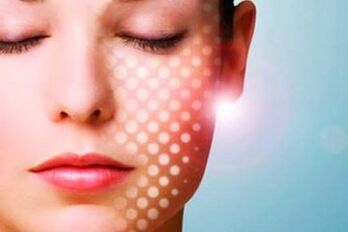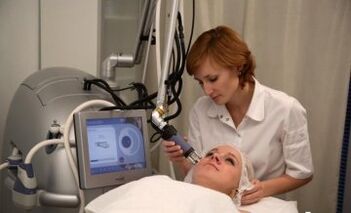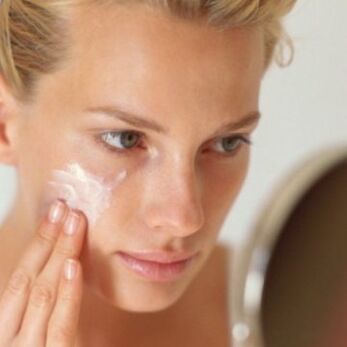
Fractional thermolysis is a method of laser "restoration" of the face and body, which helps to combat the age and stress problems of the skin.
This procedure is almost as effective as surgical braces, and after thermolysis, skin cells begin to produce collagen and elastin as actively as in youth, meaning that beneficial changes occur in several layers at the same time, not just on the outer epidermis.
The procedure is very effective, but at the same time traumatic. This can only be done in specialized clinics.
What is fractional photothermolysis, the essence and effectiveness of the method, indications and contraindications for procedures on the face and body using fractional technology, pre- and post-laser photo, effects and feedback, approximate prices and what devices were used - we will try to tell you morewe do.
general information
Thermolysis refers to the process of structural destruction of tissues under the influence of high temperatures. The concept was developed and mediated by doctors and then introduced by cosmetologists.
And photothermolysis is also a thermolysis process, but it is caused by the action of light energy. In cosmetology, it is used during photoepilation and laser "restoration" of scars and scars.
Fractional photothermolysis is a method in which photothermolysis affects only certain parts of the skin, not the entire surface. This means that by using laser (light) energy to heat them, we can talk about the focal damage of tissues.
The essence of the procedure and other names
Fractional photothermolysis is classified as a method of negative skin stimulation because a specific type of injury is used during the session, in this case burns.
To achieve the desired cosmetic effect, it is necessary to begin the process of regenerating the skin after it is damaged.
This type of thermal burn is similar to a "column" that is formed in the thickness of the dermis under the targeted action of laser beams. This "column" in cosmetology is called the "microscopic treatment zone", or abbreviated - MLZ.
In terms of diameter, they do not reach one tenth of a millimeter: about 0, 1 to 0, 4 mm, the depth of penetration is up to 0. 5 mm. Depending on the type of procedure chosen, tens to thousands of such microtraumas can be located per square centimeter of surface, and the impact rate is 3000 MLZ / sec.
If we analyze the mechanism of action of fractional photothermolysis, it is similar to mesoscooter therapy, but when using a roller, micromagnets are used mechanically using needles.
The concept of fractional thermolysis has several widely used synonyms in the practice of cosmetology:
- optical thermolysis of the skin;
- DOT therapy;
- fractional laser "grinding";
- LAFT rejuvenation;
- fractional laser nanoperforation;
Ablative and non-ablative methods
Laser ablation is the evaporation of a substance using a laser pulse. When using ablative fractional photothermolysis, choose the type of laser radiation, the energy of which is usually absorbed by water molecules.
During short-term exposure, the laser beam in the localized area almost immediately heats the water contained in the tissues to 30 ° C. As a result, the entire "column" evaporates and is replaced by an open microscopic lesion surrounded by layers of thermally coagulated cells.
Recovery after ablation photothermolysis is much slower and longer than with non-ablation.
However, the results of the procedure will be better objectively, and the lifting effect will be clearer. It is best to use a course from 2 to 6. However, during such procedures the patient is exposed to a certain risk of infection in the deeper layers of the tissues of the tissues.
Non-ablative fractional thermolysis can be associated with mild methods of microtrauma. A laser beam is used, which almost does not damage the epidermis, causing burns.
Destroyed tissue does not evaporate, but remains inside the "column", naturally there are no open wounds. Lifting is not as obvious as the first ablation method, because during the procedure, the products of cell division are eliminated, and therefore there is no effect of "pulling" the skin.
It is recommended to use 3 to 10 courses. For the patient, there is almost no risk of infection of the deeper skin layers, as there is no violation of the integrity of the face.
Instructions, effect
Indications for prescribing a procedure using Fraxel technology may be the following reasons:
- necessary stimulation of moisturized and aging skin;
- treatment of pigmented / depigmented wounds;
- get rid of scars, acne and small scars;
- The need to remove stretch marks.
Not suitable for the destruction of keloid structures.
Advantages
How is this method different from the classic "grinding" with a laser? In the traditional method, the burn affects a large area, but by the fractional effect it is localized and dotted.
There are intact skin gaps between burns, which makes photothermolysis less traumatic and speeds healing.
The method is suitable for the treatment of any part of the body, but most often it is used specifically for the face. Using Fraxel technology, a cosmetologist can also work on the skin around the eyelids.
The feature of this optical thermolysis of the dermis is the innovative design of the DOT device, which allows you not to lose skin areas or to cover one area to another.
Mechanism of action
During the preliminary consultation, the cosmetologist identifies the goals that the client wants to achieve, finds possible inconsistencies in the procedure, discusses the possible results and their compliance with the client's expectations.

The doctor will definitely point out the risks and development of post-procedural complications, as well as how to care for the skin after the course of photothermolysis.
It is necessary to discuss in advance and choose the appropriate method of pain relief, and the client must report allergic reactions to the drug, if any.
A few hours before the session is carried out superficial peeling, the purpose of which is to smooth the thickness of the stratum corneum.
During the operation, the patient may experience moderate pain and discomfort. Their severity does not depend in any way on the model of the device used. The level of pain is based on the depth and intensity of the laser beam, and these parameters are determined by the specialist himself, focusing on therapeutic goals.
The less attention is paid to the problem, the more it should affect the deeper layers.
However, ordinary creams with anesthetic effects are usually used as applied to the working areas at least 40 minutes before the start of the session.
During the session, the cosmetologist moves the staff to the surface, which emits a directed laser beam. If such a need arises, the same area is treated repeatedly over the same procedure.
Duration from 15 minutes to 1 hour. It all depends on how well the skin is processed. After fractional photothermolysis, a soothing cream is applied to the "polished" surface.
To achieve the desired result, it is necessary to conduct a course of several procedures - from 3 to 10, depending on the type of impact. You can have a session once a month.
Recommendations (training and rehabilitation)
A few days before the scheduled procedure, the patient should take a prophylactic course of antibiotics and antiviral drugs. Of course, if there is objective evidence for this.
On the day of fractional photothermolysis, a person should abstain from alcohol and completely abstain from any sports.

After the non-ablation photothermolysis procedure, the recovery process lasts up to three days, and after the ablation - at least a week.
If the "polishing" is based on ablation, the patient will have redness, swelling, burning, and discomfort for a few more days.
After consulting a specialist, you can use refrigerated compresses available in the form of sprays or apply local analgesics to the skin.
After at least three days, the color of the "polished" dermis may change slightly. For example, necrotic cells may become pseudo-burnt due to increased decomposition of pigmented residues.
Dryness occurs, peeling begins and the person may experience itching for a short time. Not all of these symptoms are dangerous and will go away on their own within a week. It is strictly forbidden to scratch itchy skin!
Here are some basic tips to help you recover from Fraxel:
- Take care of the skin and do not forget to use the recommended external means. In most cases, these drugs are prescribed for the treatment of thermal burns and moisturizing sprays;
- The crust that forms on the surface while the wounds are healing should not be removed artificially, only the natural fall;
- if before the procedure the patient took antimicrobial and antiviral drugs, their course should be continued in accordance with the instructions;
- To prevent the development of hyperpigmentation, the skin treated with sunlight should be isolated for at least a month. Usually use sunscreen with SPF 40+;
- The use of scrubs and other mechanical methods of skin cleansing during the entire recovery period is prohibited.
Possible side effects and complications
Although fractional photothermolysis is one of the most modern and safe methods, it has a number of side effects:
- development of bacterial infection, streptoderma or staphyloderma;
- erythema lasting more than three days;
- swelling on the surface of the skin treated for more than two days;
- hyperpigmentation in the post-inflammatory period;
- formation of burns, erosive cracks;
- HSV1 or exacerbation of acne;
- microscopic blood stains under the skin.
Contraindications (general and local)

Fractional photothermolysis is not performed with the following general contraindications:
- cancer;
- breastfeeding period;
- HSV1 and HSV2 in the acute stage;
- infectious diseases;
- chronic diseases in the manifestation stage;
- various types of diabetes;
- deficiencies and deficiencies of the cardiovascular system;
- dysfunction of the hematopoietic system, impaired blood clotting;
- presence of autoimmune diseases;
- tendency to form deep scars in the form of keloids;
- status epilepticus or convulsive syndrome;
- mental disorders;
- taking isotretinoin for six months;
- soon to burn or go to the solarium.
The following local contraindications:
- all inflammatory processes are localized in the work area;
- violation of the integrity of the skin;
- any tumor of unknown origin;
- Dry cleansing of the skin or any other procedure that may damage the skin.
Where and on what devices, approximate prices

The cost of a fraxel procedure depends on the area treated, so the estimated cost of fractional laser recovery varies.
Only qualified specialists can perform photothermolysis sessions in a cosmetology hospital.
Devices with CO2 or erbium lasers are used for the fractional rejuvenation procedure itself. Conventional beauty salons often do not have the necessary equipment or trained staff.
The use of lasers for cosmetic purposes is still controversial. However, laser beam-based procedures are the most popular, effective, and safe.
Reviews
We invite you to read a few reviews about fractional laser resurfacing:
- First review: "I am 35 years old. Attended 2 sessions of fractional photothermolysis. The second visit took place 30 days after the first. As a result, I noticed that my pores usually widened and narrowed a bit, and the skin on my forehead and cheeks began to look much smoother. I was grateful. The only thing that made me uncomfortable was the peeling that appeared after my second visit. But three days later he disappeared without a trace. Now I look in the mirror and enjoy my face. "
- Second review: "I want to talk about my impact on this method because I felt a positive result. After three procedures, I noticed that my face turned white, pigmented in some parts of the face, and scars began to appear. These changes were gradual, not sudden. After about 4 months, I started to look 5-6 years younger than I was. I advise everyone who takes care of themselves to try this wonderful thing.
- The third review: "I was terrified of such procedures because I thought they would have more negative consequences than pluses. However, when the first wrinkles appeared, the idea of "magical skin transformation" began to come to my mind more and more. So I decided to have a photothermolysis session. In the process, a few painful but patient feelings emerged. After a while, the face began to change for the better: wrinkles around the eyes became smoother, pale, and contoured. Overall, I liked the effect. If necessary, I will use this procedure again.
- Review 4: "I think this method is necessary for every woman who wants to stay young and attractive. I discovered something new for myself and was very grateful. There are many positive moments and all of them are reflected on my face: small wrinkles and pigmentation are gone, the skin is not so low, inflammation is less, and most importantly, I love myself very much. I would like to advise everyone to use effective procedures to preserve their beauty and youth and not to lose their beauty.














































































